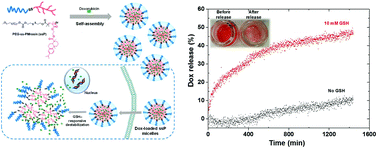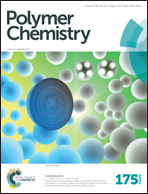Rosin-based block copolymer intracellular delivery nanocarriers with reduction-responsive sheddable coronas for cancer therapy†
Abstract
Block copolymer-based self-assembled micellar nanocarriers exhibiting glutathione-responsive enhanced release of encapsulated drugs have been considered as promising candidates for tumor-targeting drug delivery applications. Herein, we report a novel rosin-based block copolymer designed to self-assemble toward micellar nanocarriers with positioned disulfides at interfaces of hydrophobic rosin cores and hydrophilic poly(ethylene glycol) (PEG) coronas. The rosin-based micellar nanocarriers exhibit excellent colloidal stability under pseudo-physiological conditions and in the presence of proteins. Further, they enable the delivery of anticancer drugs to cancerous tissues for the enhanced release of encapsulated drugs through the destabilization of micelles with loosened structures of cores as a consequence of reduction-responsive shedding PEG coronas from rosin-based cores in response to glutathione. The results obtained from in vitro cell culture experiments including cell viability and cellular uptake suggest that reduction-responsive detachment of coronas promotes the inhibition of cell proliferation after internalization into cancer cells. These results suggest that the current design of rosin-based block copolymers and their assembled nanostructures with reduction-responsive sheddable coronas offer great versatility as intracellular drug-delivery nanocarriers for cancer therapy.


 Please wait while we load your content...
Please wait while we load your content...